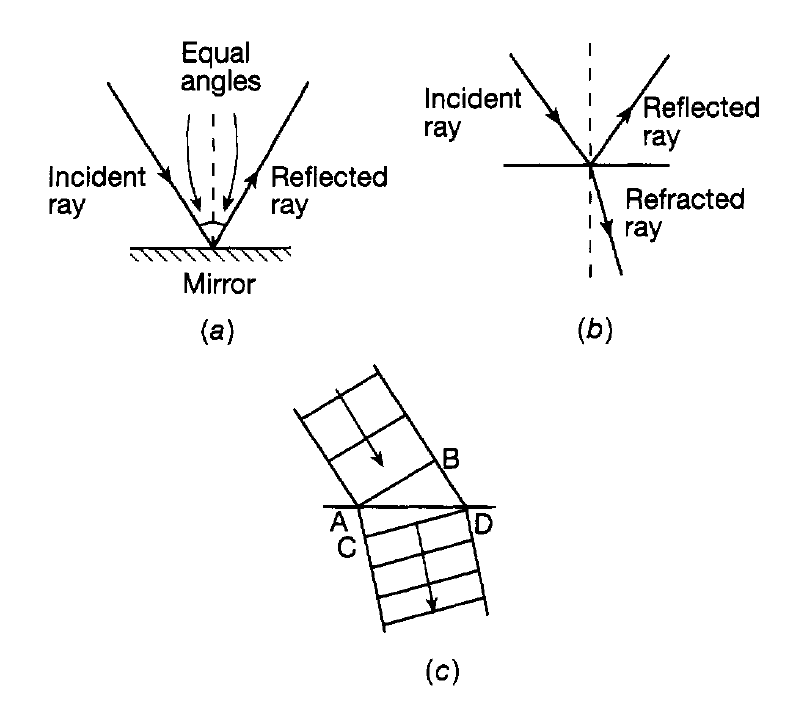


 الفيزياء الكلاسيكية
الفيزياء الكلاسيكية
 الكهربائية والمغناطيسية
الكهربائية والمغناطيسية
 علم البصريات
علم البصريات
 الفيزياء الحديثة
الفيزياء الحديثة
 النظرية النسبية
النظرية النسبية
 الفيزياء النووية
الفيزياء النووية
 فيزياء الحالة الصلبة
فيزياء الحالة الصلبة
 الليزر
الليزر
 علم الفلك
علم الفلك
 المجموعة الشمسية
المجموعة الشمسية
 الطاقة البديلة
الطاقة البديلة
 الفيزياء والعلوم الأخرى
الفيزياء والعلوم الأخرى
 مواضيع عامة في الفيزياء
مواضيع عامة في الفيزياء|
Read More
Date: 7-3-2016
Date: 8-11-2020
Date: 22-5-2016
|
The Reflection and Refraction of light
Visible light is characterized by a small spread of frequencies responsible for the different 'colours of the rainbow' violet, indigo, blue, green, yellow, orange and red in descending order of frequencies. It was by using light that the first reasonably accurate estimate of the speed of electromagnetic radiation was made by measuring the time it took a pulse of light to travel forwards and backwards (using a mirror to reflect it back) between two hill tops. This is rather like estimating the speed of sound by measuring the time it takes for an echo to return. The major difference is that whilst the latter time can be a matter of seconds, because of the high speed of light, measurements of the order of 10-4s or less are needed, requiring ingenious timing methods. Reflection of light has just been mentioned and this is an everyday experience-for example, reflection in mirrors, shop windows and so on. Mirrors have heavily silvered backs to give virtually a 100% reflection, the light being bounced off at the same angle to the perpendicular to the surface as it hits the mirror (see figure 1.1(a)), rather like a snooker ball bouncing against the edge of the table. However it is important to note that even when a material is transparent, like glass, there is still some reflection. Some of the light is transmitted through the glass and some is reflected at the surface. This is shown in figure 1.1(b) where it can be seen that the transmitted ray of light is bent towards the perpendicular to the surface. This latter process is known as refraction of light. It is interesting to note here that when light is reflected from a transparent material it becomes polarized. That means that the electric field, for example, points in a particular direction (rather than in random directions) perpendicular to the motion of the light. It is because of this that polaroid sunglasses can be used to restrict glare from reflected sunlight. Polaroid is a material in which the component (rather long) molecules are arranged in parallel lines to form a sort of grid through which polarized light has difficulty in passing unless the direction of polarization is parallel to the grid. Similarly, such grids can be used to polarize unpolarized light since only light with the field in the same direction as the grid can pass through it. The refraction or bending of light just referred to underlies the function of lenses, for example a magnifying glass, and it is important to understand the orgin of this bending. Consider the more detailed diagram of a ray of light incident on a glass surface in figure 1.1(c) where the lines across the ray again represent successive peaks in the amplitude of the light wave, the distance

Figure 1.1: (a) Reflection of light; (b), (c) refraction of light.
between them being one wavelength. In glass, light travels at a slower speed than in air and so in the time that the end B of the wave front reaches D the end A travels a shorter distance to C. This results in the ray bending towards the vertical as shown. The wavelength in the glass obviously becomes shorter, this resulting from the relation between frequency, wavelength and wave speed where it can be seen that the wavelength is simply proportional to the speed. The speed of light waves in glass depends on the frequency of the wave, i.e. the colour of the light, the slowest speed being for violet and the fastest for red. This, in turn, means that a violet ray is bent most and a red ray least in passing from air to glass. We speak of the light being dispersed. This spreading out of different colours is seen at its most spectacular in the formation of a rainbow which results from the dispersion of sunlight through myriads of raindrops. The fact that sunlight splits up into the different ‘rainbow’ colours implies that it is a mixture of all these colours. Such light is referred to as white light since it is perceived to be essentially colourless by the eye. When white light falls, for example, onto a green object then colours other than green are absorbed by the object and only green light is reflected; the object therefore looks green. This means that a green car illuminated at night by orange coloured fluorescent street lighting will absorb the orange light and there will be little, if any, green light to reflect back; so virtually no light will be reflected and the car will look black. Similarly the open sky looks blue because the air molecules tend to reflect (scatter) blue light passing through it from the sun. In turn, if we look at the sun directly when it is just above the horizon its white light will have had the blue component significantly reduced because of scattering in the air it has traversed. The residual light, having lost most of its blue component, therefore becomes reddish, leading to the magnificent sunsets often observed.



|
|
|
|
دخلت غرفة فنسيت ماذا تريد من داخلها.. خبير يفسر الحالة
|
|
|
|
|
|
|
ثورة طبية.. ابتكار أصغر جهاز لتنظيم ضربات القلب في العالم
|
|
|
|
|
|
|
سماحة السيد الصافي يؤكد ضرورة تعريف المجتمعات بأهمية مبادئ أهل البيت (عليهم السلام) في إيجاد حلول للمشاكل الاجتماعية
|
|
|